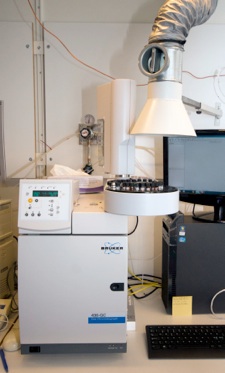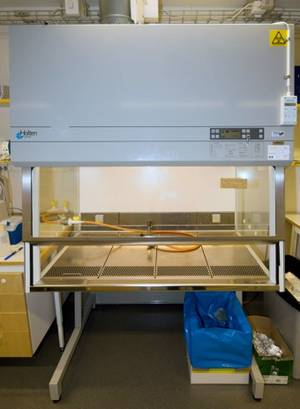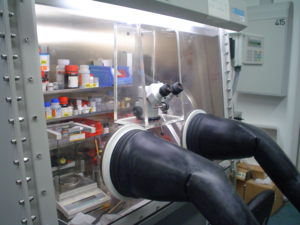4.3 Ventilated workstations
Regulations for work involving fume hoods/benches
Work using fume hoods and fume benches is affected by the surroundings and by the individual work method as well as by the design of the supply and extraction air systems. It is easy to disrupt the function of the fume hood/bench by using incorrect work methods, resulting in reduced safety. The following rules mean that work can be carried out safely, reducing the risk of leakage and harmful exposure.
Fume hoods and fume benches have controls/alarm functions which warn when the extraction airflow rate is too low. Routine maintenance and repairs of fume hood/benches are conducted by facilities management.
Rules
- Laboratory setups of open containers with flammable materials (ie not closed assemblies) shall be supervised by staff, if a loss of ventilation causes risk of forming an explosive atmosphere.
- During electrical or ventilation outages, close all containers with flammable material, shut down heating in the laboratory set-up and then close the hatch. Read more: 9.1 Plan of Action for Power and/or Ventilation Failure.
- Electrical equipment in the fume hood should only be connected via interlocked electrical power outlets. Electrical power to these electrical power outlets are interrupted at loss of ventilation. Electrical equipment marked with an EX-classification sign (pictured below) is an exception.
- Follow the EX-classification instruction for the fume hood and laboratory. This instruction informs you regarding zones where only electrical equipment marked "EX" is permitted. No exceptions allowed.
- Power sockets should never be placed inside, under or in front of the fume hood.
- Acids that produce corrosive gases/fumes e.g. perchloric acid, aqua regia and concentrated hydrochloric acid must only be handled in special, flushable fume hoods. Read more: 5.6 Corrosives.

Fume hood
- Work with the hood sash (hatch) in the lowest practical position, i.e. with the normal maximum of 30 cm opening. The sash acts as a physical barrier in the event of an accident. Keep the sash closed when not conducting work in the hood.
- Carry out the work as far into the fume hood as possible.
- Do not clutter your hood with unnecessary bottles or equipment. Keep it clean and clear. Only materials actively in use should be in the hood.
- Do not store chemicals or anything else in the fume hood.
- Save energy by closing the fume hood hatch when no work is being carried out.
Fume Bench
- Fume benches should only be used for cold work (<50 °C).
- 2/3 of the perforated surface should be free.
- The source of contamination should be placed at least 10 cm behind the perforations.
- Fume benches can be supplied with protective covers, which increase safety.
- If protective covers are not used, any source of contamination should not be placed higher than 15-20 cm above the work surface.
- A protective cover increases safety height and a larger proportion of the perforated surface can be used as a work surface.
- It is critical that the perforated benchtop surface be held clean and free of dirt/dust and chemical debris because such debris could impede the airflow and lead to poorer protection.
Local exhaust ventilation

Place the local exhaust ventilation point as close as possible to the source of contamination. Maximum distance equals diameter of the extraction tubing.
LAF bench

Open Laminar Air Flow (LAF) benches are used for product protection (sterile work) and closed LAF benches are used for product and operator protection. The LAF bench should be connected to the exhaust ventilation system.
Note: If you only require personal protection, a fume hood/bench always provides the best protection.
Glove box
In addition to fume hoods, some laboratories use contained glove box units for working with reactive chemicals under inert environment, working with very toxic substances in a completely closed system, or for creating a stable, breeze free system for weighing hazardous or reactive materials. These units can be very effective because they offer complete containment. If you have not used a particular glove box before, it is essential that you consult a person responsible for that glove box before attempting to use it.
Remember that the glove box is a shared space between members of many groups.
- It is important to determine what types of material / chemicals can be stored within the glove box.
- Label everything that you intend to keep in the glove box and place it in a storage container.
- Remove chemicals/reagents that are no longer required.
- Remove waste in a timely manner. Do not allow it to accumulate.
- Hazardous waste containers in the glovebox must be appropriately labeled at all times.

